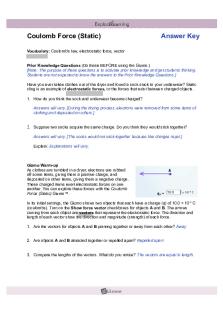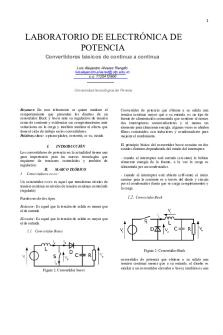Coulombforcese key - cc PDF

| Title | Coulombforcese key - cc |
|---|---|
| Course | Intro to science with lab |
| Institution | Concordia University |
| Pages | 5 |
| File Size | 278.5 KB |
| File Type | |
| Total Downloads | 96 |
| Total Views | 168 |
Summary
cc...
Description
Coulomb Force (Static)
Answer Key
Vocabulary: Coulomb’s law, electrostatic force, vector
Prior Knowledge Questions (Do these BEFORE using the Gizmo.) [Note: The purpose of these questions is to activate prior knowledge and get students thinking. Students are not expected to know the answers to the Prior Knowledge Questions.] Have you ever taken clothes out of the dryer and found a sock stuck to your underwear? Static cling is an example of electrostatic forces, or the forces that exist between charged objects. 1. How do you think the sock and underwear became charged? Answers will vary. [During the drying process, electrons were removed from some items of clothing and deposited on others.]
2. Suppose two socks acquire the same charge. Do you think they would stick together? Answers will vary. [The socks would not stick together because like charges repel.] Explain: Explanations will vary.
Gizmo Warm-up As clothes are tumbled in a dryer, electrons are rubbed off some items, giving them a positive charge, and deposited on other items, giving them a negative charge. These charged items exert electrostatic forces on one another. You can explore these forces with the Coulomb Force (Static) Gizmo™. In its initial settings, the Gizmo shows two objects that each have a charge (q) of 10.0 × 10-4 C (coulombs). Turn on the Show force vector checkboxes for objects A and B. The arrows coming from each object are vectors that represent the electrostatic force. The direction and length of each vector show the direction and magnitude (strength) of each force. 1. Are the vectors for objects A and B pointing together or away from each other? Away
2. Are objects A and B attracted together or repelled apart? Repelled apart
3. Compare the lengths of the vectors. What do you notice? The vectors are equal in length.
Get the Gizmo ready: Activity A:
Turn on Show grid. Place object A on the x-axis at -5 and object B on the x-axis at +5.
The effect of charge
Check that Show force vector is turned on for each object.
Question: How does charge affect the strength of the electrostatic force? 1. Observe: You can change the charge of each object by entering the desired value in the qA and qB boxes. Observe the force vectors for each of the situations listed in the table below. Based on the force vectors, state whether the objects are repelled from one another, attracted to one another, or if there is no force at all. qA
Attraction, repulsion, or no force?
qB -4
-4
1.0 × 10 C
1.0 × 10 C
Repulsion
-1.0 × 10-4 C
1.0 × 10-4 C
Attraction
-4
-4
-1.0 × 10 C
-1.0 × 10 C
Repulsion
1.0 × 10-4 C
0.0 × 10-4 C
No force
2. Make a rule: Complete the following sentences with the words “attract,” “repel,” or “zero.” When the charges are the same, the two objects repel one another. When the charges are opposite, the two objects attract one another. When one of the objects has no charge, the resulting force is zero.
3. Predict: How do you think the magnitude of the electrostatic force between two objects will change if the charge of each object was doubled? Predictions will vary.
4. Measure: Turn on Show vector notation for both objects. Set the charge of objects A and B to 1.0 × 10-4 C. The force on object A is now -0.9i + 0j N. That means that the force is -0.9 N in the x direction and 0.0 N in the y direction. A. What is the magnitude of the force on object A? |FA| = 0.9 N B. What is the magnitude of the force on object B? |FB| = 0.9 N C. The force on object A is negative. What does this indicate about the direction of the force? The negative value indicates the force on A points to the left. (Activity A continued on next page)
Activity A (continued from previous page) 5. Gather data: For each charge combination listed in the table below, write magnitude of the force on object A. (Note: The magnitude of the force, or its strength, is always positive.) qA
qB
|FA|
Factor
qA × qB
1.0 × 10-4 C
1.0 × 10-4 C
0.9 N
1
1.0 × 10-8 C
1.0 × 10-4 C
2.0 × 10-4 C
1.8 N
2
2.0 × 10-8 C
2.0 × 10-4 C
2.0 × 10-4 C
3.6 N
4
4.0 × 10-8 C
2.0 × 10-4 C
3.0 × 10-4 C
5.4 N
6
6.0 × 10-8 C
6. Analyze: What patterns do you notice in the data? Sample answer: When one charge is doubled, the force doubles. When both charges are doubled, the force is multiplied by four.
7. Calculate: To calculate how much the force is multiplied, divide each force by the first value, 0.9 N. Fill in these values under Factor in the table. What do you notice? Sample answer: The factor doubles when one of the forces is doubled.
8. Calculate: Calculate the product of the two charges, and fill in these values in the last column. Compare these numbers to the Factor numbers. What do you notice? The product qA × qB is proportional to the force factor. 9. Apply: What would you expect the force to be if the charge of object A was 5.0 × 10-4 C and the charge of object B was 4.0 × 10-4 C? 18.0 N [The product of the charges is 20 × 10-8, so the factor is 20: 20 × 0.9 = 18.0] Check your answer with the Gizmo.
10. Challenge: Based on what you have learned, write an equation for the strength of the electrostatic force for two charges that are separated by 10 meters. Use the Gizmo to check your equation. F = (0.9 × 108)·qA·qB Note: Equations may vary. Check that student equations are equivalent to this one.
Activity B:
Get the Gizmo ready:
Turn on Show distance. Set qA to 10.0 × 10-4 C and qB to 1.0 × 10-4 C.
The effect of distance
Question: How does distance affect the strength of the electrostatic force? 1. Observe: Move object A back and forth. How does the distance between the objects affect the strength of the electrostatic force between them? The magnitude of the electrostatic force decreases and the objects move apart.
2. Predict: How do you think the electrostatic force between two objects would change if the distance between the two objects was doubled? Predictions will vary.
3. Measure: Place object A on the x-axis at -2, and object B on the x-axis at +1. A. What is the magnitude of the force on object A? |FA| = 100 N B. What is the magnitude of the force on object B? |FB| = 100 N 4. Gather data: Check that qA is 10.0 × 10-4 C and qB is 1.0 × 10-4 C. For each position of object A, record the distance between the objects and the force on object A. Object A
Object B
Distance (m)
|FA| (N)
Distance factor
Force factor
1 Dist. factor2
(-2, 0)
(1, 0)
3m
100 N
1
1.00
1.00
(-5, 0)
(1, 0)
6m
25 N
2
0.250
0.250
(-11, 0)
(1, 0)
12 m
6.25 N
4
0.0625
0.0625
(-14, 0)
(1,0)
15 m
4N
5
0.04
0.04
5. Calculate: To calculate the distance factor, divide each distance by the original distance (3 m). To calculate the force factor, divide each force by the original force (100 N).
A. How does the force change as the distance increases? The force decreases as the distance increases.
B. Now find the reciprocal of each distance factor squared. What do you notice? The force factor is equal to the reciprocal of the distance factor squared. (Activity B continued on next page)
Activity B (continued from previous page) 6. Apply: What would you expect the force to be if the distance was 30 meters? 1 N How did you come up with your answer? Sample answer: The distance factor is 10 (30 m ÷ 3 m). The reciprocal of the distance factor is 0.1. The square of this value is 0.01. Therefore the force factor is 0.01 and the resulting force is 0.01 × 100, or 1 N. Use the Gizmo to check your answer.
7. Make a rule: Based on what you have learned, write an equation to calculate the force between two objects if the product of their charges is 10.0 × 10-4 C. Use the Gizmo to test your formula. (Note: Use the variable R for the distance between the charges.) F=
900 R
2
8. Summarize: Fill in the blanks. The electrostatic force between two objects is proportional to the reciprocal of the distance squared.
9. Challenge: Coulomb’s law is an equation that relates the electrostatic force between two objects to their distance and charge. In activity A, you found that the electrostatic force between two objects is proportional to the product of their masses. Combine that with what you have learned in this activity to complete Coulomb’s law below. (Hint: In the equation, k is a constant.) Check your answer with your teacher.
Fq = k
q A qB R2
10. On your own: Use the Gizmo to find the value of k in the formula above. List the value and describe how you found it below. The units of k are newton · meter2 ÷ coulombs2, or N·m2/C2. Check your answer with your teacher. k = 9.0 × 109 [Note: The actual value of k is 8.99 × 109.] Show your work: Sample answer: If qA = 10.0 × 10-4 C, qB = 1.0 × 10-4 C, and R = 30 m, then Fq = 1 N.
Fq k
q AqB R
2
k
Fq R 2 q AqB
k
1 30 2 1.0 10 7
900 9 k 9 .0 10 7 1. 0 10...
Similar Free PDFs

Coulombforcese key - cc
- 5 Pages

Convertidor CC-CC
- 12 Pages

CC Practical
- 21 Pages

CC A1O2
- 2 Pages

CC 102 - concept charts
- 19 Pages

CC Short + Long Questions
- 64 Pages

Waiting to Exhale CC
- 4 Pages

CC 306 Zusammenfassung
- 36 Pages

Cuaderno redaccion trabajo cc
- 39 Pages

Apuntes Illustrator CC 4
- 7 Pages

AE CC 01 MANUALpf
- 18 Pages

Tecnño - Apuntes CC
- 2 Pages

paper examen seminarie CC
- 11 Pages

Espinoza Ramirez PA1 CC
- 3 Pages
Popular Institutions
- Tinajero National High School - Annex
- Politeknik Caltex Riau
- Yokohama City University
- SGT University
- University of Al-Qadisiyah
- Divine Word College of Vigan
- Techniek College Rotterdam
- Universidade de Santiago
- Universiti Teknologi MARA Cawangan Johor Kampus Pasir Gudang
- Poltekkes Kemenkes Yogyakarta
- Baguio City National High School
- Colegio san marcos
- preparatoria uno
- Centro de Bachillerato Tecnológico Industrial y de Servicios No. 107
- Dalian Maritime University
- Quang Trung Secondary School
- Colegio Tecnológico en Informática
- Corporación Regional de Educación Superior
- Grupo CEDVA
- Dar Al Uloom University
- Centro de Estudios Preuniversitarios de la Universidad Nacional de Ingeniería
- 上智大学
- Aakash International School, Nuna Majara
- San Felipe Neri Catholic School
- Kang Chiao International School - New Taipei City
- Misamis Occidental National High School
- Institución Educativa Escuela Normal Juan Ladrilleros
- Kolehiyo ng Pantukan
- Batanes State College
- Instituto Continental
- Sekolah Menengah Kejuruan Kesehatan Kaltara (Tarakan)
- Colegio de La Inmaculada Concepcion - Cebu

